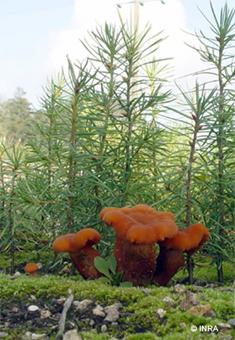
Tree species dominating forest ecosystems in boreal, temperate and montane regions (e.g., pines, oaks ) develop symbiotic associations, so-called ectomycorrhizas, with soil fungi. Ectomycorrhizal roots have a beneficial impact on plant growth in natural and agroforestry ecosystems. Central to the success of these mutualistic symbioses is the exchange of nutrients between the partners. The prospecting and absorbing extraradical hyphal web captures soil minerals (P, N, water) and organic nitrogen, assimilates and translocates a large proportion of them to roots of the growing host plant. On the other hand, the fungus within the root is protected from competition with other soil microbes and, therefore, is a preferential user of the plant carbon (ca 10-20% of the host photoassimilates). To elucidate the genetic basis of this ecologically important behavior, we have sequenced the sixty-five million base-pair genome of the ectomycorrhizal fungus Laccaria bicolor to high draft using a whole genome shotgun method. This is the first symbiotic fungus genome to be sequenced.
The symbiotic fungus Laccaria bicolor (common name: bicoloured deceiver) is a member of the Tricholomataceae, a large order of ectomycorrhizal and saprobic basidiomycetes. Laccaria is a cosmopolitan and common genus of Agaricales which has been reported from numerous ectomycorrhizal plant communities. The systematics, biogeography, and ecology of Laccaria have been well-studied. The physiological ecology of L. bicolor is well studied among ectomycorrhizal taxa, because it grows rapidly in pure culture and its mycorrhiza are easily established with tree roots under laboratory conditions. Finally, this species is used in large-scale commercial inoculation programs in forest nurseries worldwide to enhance growth of tree seedlings.
Comparison of the genomes of the different pathogenic and saprobic fungi with the Laccaria genome will be of interest to a wide range of genome and evolutionary scientists. It will provide critical insights into the genetic makeup of plant-fungus interactions.
Characterization of the interactions between Populus and its symbiotic associate, Laccaria bicolor , would allow in-depth exploration of the coordinated community response to these abiotic and biotic stresses, thus adding a needed dimension to climate change research and providing another step in the quest for mechanistic modeling of ecosystem responses. The overall purpose of the initiative is to build on available resources and to provide a comprehensive understanding of the symbiotic process and related fungal biology and ecology.
Genome Reference(s)
Martin F, Aerts A, Ahrén D, Brun A, Danchin EG, Duchaussoy F, Gibon J, Kohler A, Lindquist E, Pereda V, Salamov A, Shapiro HJ, Wuyts J, Blaudez D, Buée M, Brokstein P, Canbäck B, Cohen D, Courty PE, Coutinho PM, Delaruelle C, Detter JC, Deveau A, DiFazio S, Duplessis S, Fraissinet-Tachet L, Lucic E, Frey-Klett P, Fourrey C, Feussner I, Gay G, Grimwood J, Hoegger PJ, Jain P, Kilaru S, Labbé J, Lin YC, Legué V, Le Tacon F, Marmeisse R, Melayah D, Montanini B, Muratet M, Nehls U, Niculita-Hirzel H, Oudot-Le Secq MP, Peter M, Quesneville H, Rajashekar B, Reich M, Rouhier N, Schmutz J, Yin T, Chalot M, Henrissat B, Kües U, Lucas S, Van de Peer Y, Podila GK, Polle A, Pukkila PJ, Richardson PM, Rouzé P, Sanders IR, Stajich JE, Tunlid A, Tuskan G, Grigoriev IV
The genome of Laccaria bicolor provides insights into mycorrhizal symbiosis.
Nature. 2008 Mar 6;452(7183):88-92. doi: 10.1038/nature06556
